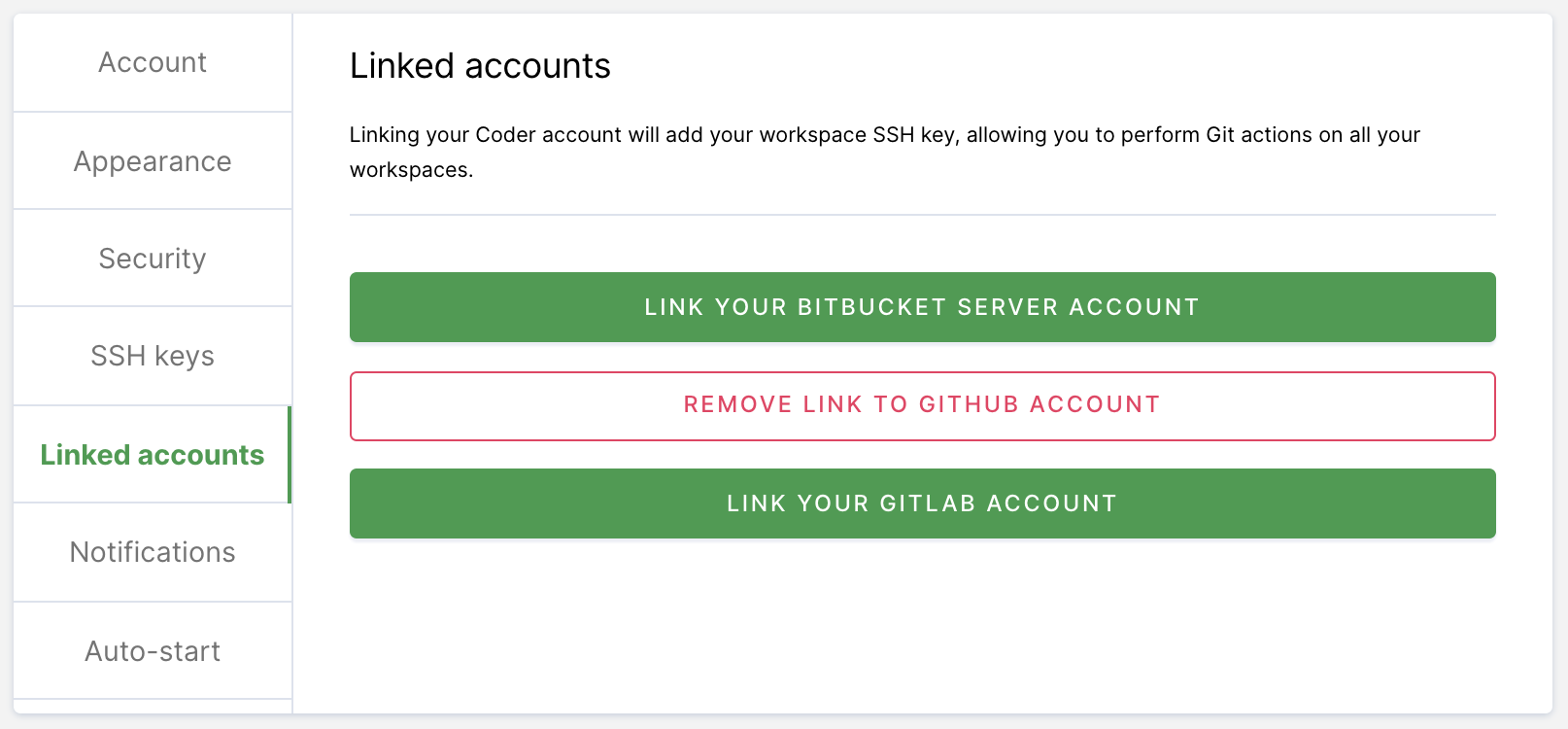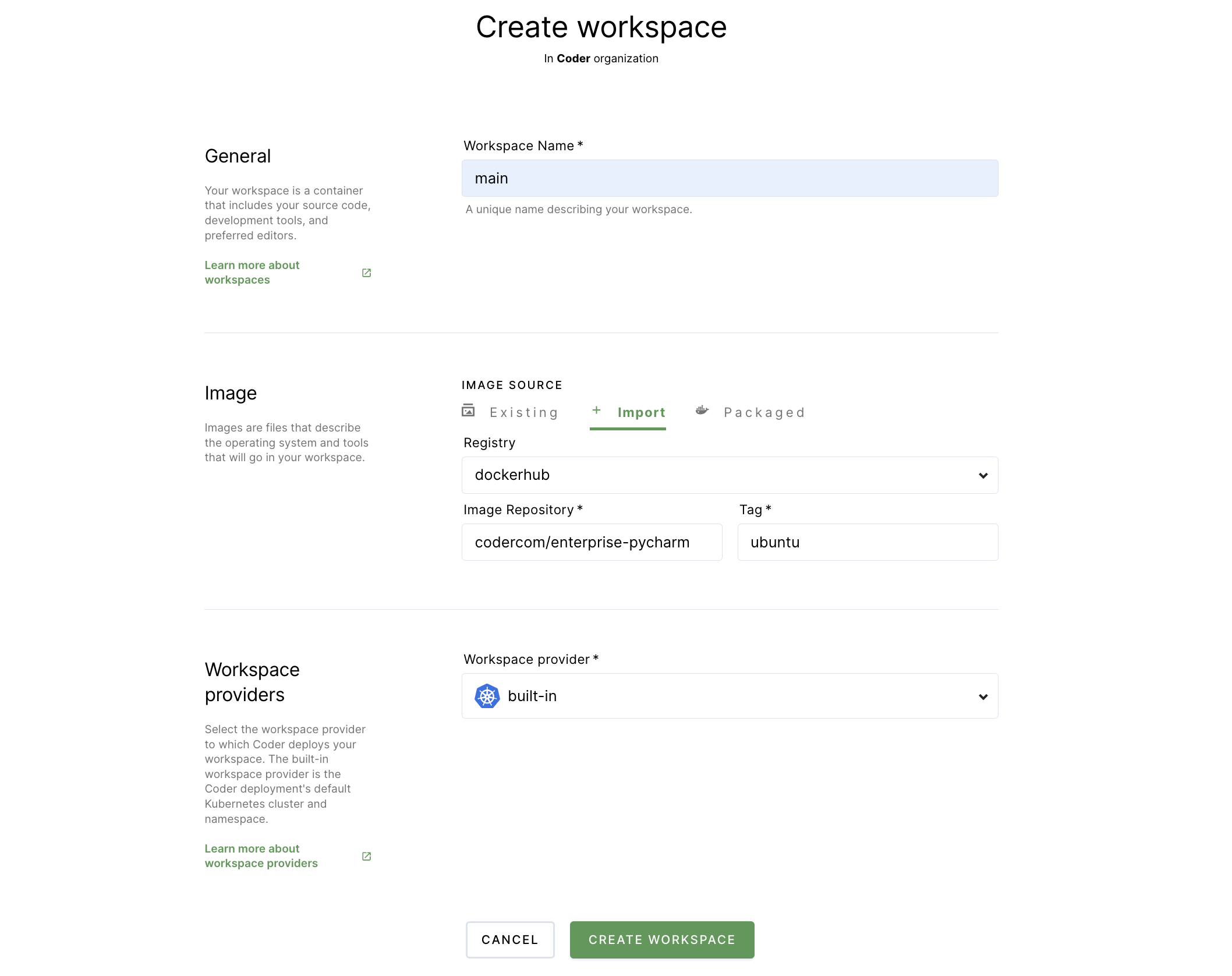PyCharm
This article will walk you through the process of getting started with a Coder workspace and a project that leverages PyCharm. You'll learn how to:
- Connect Coder to your Git provider;
- Create a workspace;
- Create your first Python project;
- Push your changes to GitHub.
Prerequisites
This guide assumes that you have a Coder deployment available to you and that you have the credentials needed to access the deployment.
Step 1: Log in and connect Coder to your Git provider
In this step, you'll log into Coder and connect and authenticate with your Git provider. This will allow you to do things like pull repositories and push changes.
-
Navigate to the Coder deployment using the URL provided to you by your site manager, and log in.
-
Click on your avatar in the top-right, and select Account.

-
Provide Coder with your SSH key to connect and authenticate to GitHub.
If your site manager has configured OAuth, go to Linked Accounts and follow the on-screen instructions to link your GitHub account.

If your site manager has not configured OAuth, go to SSH keys. Copy your public SSH key and provide it to GitHub.

Step 2: Create your workspace
You will now create the workspace to work on your development project.
-
Return to Workspaces using the top navigation bar.
-
Click New workspace to launch the workspace-creation dialog.
-
Provide a Workspace Name.
-
In the Image section, click Packaged (this tab contains Coder-provided images hosted in a Docker registry). Select PyCharm. This will populate the form in the Import tab.
-
Under Workspace providers, leave the default option (which is built-in) selected.
-
Expand the Advanced section. If the Run as a container-based virtual machine option is selected, unselect the box. Leave the CPU, Memory, Disk, and GPU allocations as-is.
-
Scroll to the bottom and click Create workspace. The dialog will close, allowing you to see the main workspace page. On the right-hand side, you can track the workspace build process using the Build log.

Once your workspace is ready for use, you'll see a chip that says Running next to the name of your workspace.
Step 3: Create a sample project file in your workspace
Once you've created your workspace, you can start working in Coder. For the purposes of this article, we'll leverage JetBrains' tutorial on how to Create and run your first Python project.
-
Under Browser applications, click PyCharm Community to open the IDE in your browser. Follow the prompts to accept the license agreement and determine data sharing permissions.
-
On the Welcome to PyCharm screen, click New Project.
-
In the window that pops up:
- Provide the Location where PyCharm should save your files (for this
example, we changed the highlighted portion to
task, but you can name the folder whatever you'd like)) - Ensure that New environment using Virtualenv is selected.
- Make sure to uncheck the option to Create a main.py welcome script.
- Click Create to proceed.
- Provide the Location where PyCharm should save your files (for this
example, we changed the highlighted portion to
-
In the left-hand navigation bar, right-click on the root of your folder (for example, if you named the folder
task, you would click where it says task in the navbar) and select New > File. When prompted, provide a name for your file (e.g.,car.py). -
The IDE automatically opens your new, empty file, allowing you to edit. Copy and paste the following sample app from JetBrains:
class Car: def __init__(self, speed=0): self.speed = speed self.odometer = 0 self.time = 0 def say_state(self): print("I'm going {} kph!".format(self.speed)) def accelerate(self): self.speed += 5 def brake(self): if self.speed < 5: self.speed = 0 else: self.speed -= 5 def step(self): self.odometer += self.speed self.time += 1 def average_speed(self): if self.time != 0: return self.odometer / self.time else: pass if __name__ == '__main__': my_car = Car() print("I'm a car!") while True: action = input("What should I do? [A]ccelerate, [B]rake, " "show [O]dometer, or show average [S]peed? ").upper() if action not in "ABOS" or len(action) != 1: print("I don't know how to do that") continue if action == 'A': my_car.accelerate() elif action == 'B': my_car.brake() elif action == 'O': print("The car has driven {} kilometers".format(my_car.odometer)) elif action == 'S': print("The car's average speed was {} kph".format(my_car.average_speed())) my_car.step() my_car.say_state() -
At this point, you can run your application by right-clicking on the IDE editor window and selecting Run
. Once the app starts, you can interact with it using the terminal at the bottom.
Step 5: Push your repo to GitHub
The following steps show you how to push your app to a newly created GitHub repo.
-
Log in to GitHub and navigate to Create a new repository.
-
Provide a repository name and click Create repository.
-
Return to your workspace, and click Terminal at the bottom.
-
Run the following to turn your directory into a Git repository and commit your initial changes:
cd .. git init <nameOfDirectory> cd <nameOfDirectory> git add -A git commit -am "Initial commit" -
Run the following in your terminal to add a remote to your GitHub repo, change the primary branch name to
main, and push the contents to your newly created repo:git remote add origin git@github.com:<username>/<repoName>.git git branch -M main git push origin main -
Within the IDE window (near the top), you'll be prompted to log in to GitHub by providing your username and password/personal access token.
-
Next, Code Web will display an alert that says the GitHub extension wants to sign in; click Allow to proceed.
-
In the subsequent window, click Continue to authorize Visual Studio Code to access GitHub.
At this point, the contents of your repo should be pushed to GitHub.